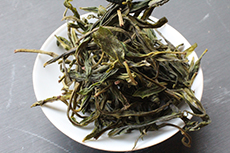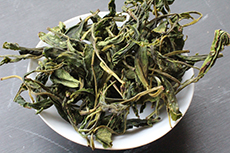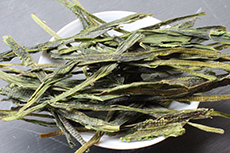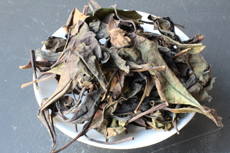.
Search results
Results 1 till 6 of a total of 6 (1 pages).
-
Blog Länggass-Tee
-
Da Ye Zhong
-
Tai Ping Hou Kui Chuan Tong
A genuine and original Taiping Houkui from Hougang, produced using the traditional method. a tea of top quality from a small tea garden. A (successful) attempt to recreate the Tea from the World Exhibition of 1915. Hence the name Chuan Tong meaning classic. The leave form is flat but neither stretched nor pressed. Very carefully and consciously crafted from old tea-bushes of different types of the Shidacha. The leaves are smaller and less heavily pressed, one can recognise the leaves and the buds more distinctly. The taste is very different to the modern version of this tea.Tai Ping Hou Kui, Ape King from the Taiping Lake, is a very beautifully crafted flat form tea (Bianxingcha) with very large leaves that were hammered into shape. They are considered to be one of the classic Chinese green teas, although the first mention of them appears only after 1900, when the improved techniques made more beautiful and better qualities possible. The very long leaves of the Shidacha variety are fired in the wok and carefully pressed by hand and hammered. Nowadays, they are also produced by machine, resulting in very flat and long, light green leaves. -
Tai Ping Hou Kui Version 1915
A genuine and original Taiping Houkui from Huogang, produced using a semi-traditional method. A (successful) attempt to recreate the Tea from the World Exhibition of 1915, hence the name. Very carefully and consciously crafted from old tea-bushes of different types of the Shidacha. The leaves are smaller and less heavily pressed, one can recognise the leaves and the buds more distinctly. The taste is very different to the modern version of this tea.Tai Ping Hou Kui, Ape King from the Taiping Lake, is a very beautifully crafted flat form tea (Bianxingcha) with very large leaves that were hammered into shape. They are considered to be one of the classic Chinese green teas, although the first mention of them appears only after 1900, when the improved techniques made more beautiful and better qualities possible. The very long leaves of the Shidacha variety are fired in the wok and carefully pressed by hand and hammered. Nowadays, they are also produced by machine, resulting in very flat and long, light green leaves. -
Tai Ping Hou Kui
A genuine and original Taiping Houkui from Houkeng, produced using the modern method, i.e. the leaves are pressed into flat long shapes. This process is carefully done so that the leaves don't become too flat; individual leaves are still identifiable.Tai Ping Hou Kui, King Ape (from) the Taiping (Lake), is a very beautifully crafted flat form tea (Bianxingcha) with very large leaves that were pressed into shape. Taiping Houkui is considered to be one of the classic Chinese green teas, although the first mention of him appears only after 1900, when the improved techniques made more beautiful and better qualities possible. The very long leaves of the Shidacha variety are fired in the wok and carefully pulled apart and pressed. Nowadays on the market one can also find light green leaves machine-processed resulting in very flat and long. -
Hou Kui Bai Cha 2017
A white tea that is produced from a later harvest of the same trees that are being used for the genuine Tai Ping Hou Kui - hence a bit of an extravagant thing. Three leves are being harvested for this tea, the bud has already opened, thus the leaves are similar to what is used for a Bai Mu Dan or even a Shou Mei (later harvest, fully grown leaves). The leaves have been left to wither over a long period and have then be dried over charcoal. The result is a large leafed, wonderful white tea. It has been kept in China until 2019 and can be drunk immediately as well as being kept.
.











